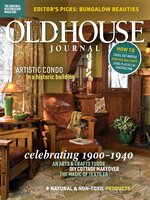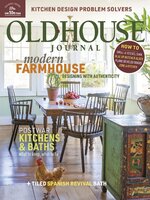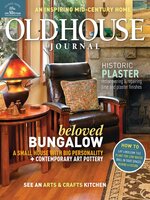The Original Restoration Magazine for people who are passionate about old houses to repair, rehabilitate, update, and decorate their homes; covering all classic American architectural styles,—from the earliest Colonial-era buildings to grand Victorians of every variety to Arts & Crafts bungalows and mid-century ranches.
Historic Preservation Month
SIDE NOTES
Old House Journal
What’s on the Floor • Finishes for the hardest working surface in the house.
Lighting Over Time • Illumination for interiors: 18th century to the present.
$299,900 & under • Charm and character lurk in these distinctive homes built between 1820 and 1938.
A DEFT REFURBISHMENT • With features missing or unsalvageable, the house needed a facelift—in keeping with the architecture.
DESIGN
original period built-ins PERMANENT FURNITURE FOR EVERY ERA • Immovable built-ins are part of the architecture, contributing to the look of the house as much as the staircase or mantel does. They take up less space than standard furniture, especially if they are recessed into walls. They don’t need to be moved during cleaning. Built-in furniture is ideal for a small home, whether it’s a period bungalow or today’s tiny house. Built-ins also serve the modern desire for uncluttered interiors. • The idea is not new. We find built-ins in every era and house style. Some are simple or traditional, some drip with design and craftsmanship, and some are a little nutty. Here we look at a few originals.
Permanent Furniture, 1917 • From “Better Built Homes, Vol. II” by Curtis Lumber & Millwork.
CARVED WOOD SIGNS
Arts & Crafts Design, Built In • A modern kitchen has the appeal of an Arts & Crafts living room.
RESTORE
comeback FLOORS • Floors hand-cut or milled from old-growth woods can withstand decades of abuse. Over the arc of time, however, settling and subsidence, careless repairs, and damage from water or pets create challenges for even these hardy survivors.
EXCAVATING for GOLD
Trimming a Damaged Board
HOME COOKING
SQUEAKING & bouncing
SHOPTOUR: WHIDBEY MILLHOUSE
FILLING WOODgaps
ALTERNATIVE finishes
FINISHED BY hand
For Outside • Tried-and-true products to repair or improve the exterior.
Carpeting the Stairs • A staircase runner adds comfort and safety, color, pattern, and a period touch.
DECORATIVE DETAILS • ON RODS, CLIPS & DUST CORNERS
Balcony Bits Find Decorative Reuse • Ornate wrought iron with patina is treasured.
ANDIRONS or firedogs
Dealing with Popcorn Ceilings • If these methods fail, you’ll have to remove the ceiling and replace it with drywall or plaster.
When Spacing Balusters • When rebuilding a porch or staircase rail, it’s important to match the spacing of the original spindles or balusters. Building codes recommend the space between balusters be no greater than four inches. Happily, most 19th- and early-20th-century balusters were spaced closer together than that. The spacing was often one-and-a-half to two times the width of a baluster, though this might vary. • How do you mark the spacing, given the di? culty of dividing a length of rail into inches with awkward fractions? Builders have left us with a traditional tool called dividers. It looks like a drafting compass with two points. Dividers are used in everything from engineering to navigation. • For the task at hand, begin by marking a start and end line on the rail (usually an inch or two from each end) and now mark divisions with the dividers.
INSPIRE
The House that A POTTERY BUILT • William Day Gates, founder of an important terra-cotta tile and pottery company, built his retirement home in 1927. Decades later, it would take a...

 March/April 2025
March/April 2025
 January/February 2025
January/February 2025
 New Old House 2025
New Old House 2025
 November/December 2024
November/December 2024
 Arts & Crafts Homes 2025
Arts & Crafts Homes 2025
 September/October 2024
September/October 2024
 July/August 2024
July/August 2024
 Renovation Lookbook 2024
Renovation Lookbook 2024
 May/June 2024
May/June 2024
 March/April 2024
March/April 2024
 January/February 2024
January/February 2024
 New Old House 2024
New Old House 2024
 November/December 2023
November/December 2023
 September/October 2023
September/October 2023
 July/August 2023
July/August 2023
 Renovation Lookbook 2023
Renovation Lookbook 2023
 May/June 2023
May/June 2023
 March/April 2023
March/April 2023
 January/February 2023
January/February 2023
 New Old House 2023
New Old House 2023
 November/December 2022
November/December 2022
 Arts & Crafts Home 2023
Arts & Crafts Home 2023
 September/October 2022
September/October 2022
 Finding Home 2022
Finding Home 2022